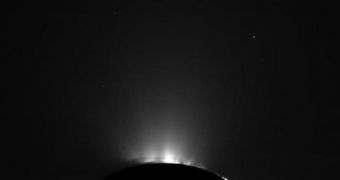The NASA Cassini orbiter carried out a new flyby of the Saturnine moon Enceladus on October 19. The spacecraft was able to collect a series of new images of the object, which is of interest to scientists because it may contain an ocean of liquid water under miles of ice crust.
During the new flight, the space probe was able to capture new images of the jets spewing out of Enceladus' south pole. Tiger stripe features at this location release large amounts of water-ice vapors and organic molecules, which go on to fuel Saturn's atmosphere.
Some of the particles also contribute to the gas giant's E Ring, whereas other still fall towards the surface of the moon as snow. This flyby was special because Cassini had access to a dual stellar occultation.
What this means is that it used two of three stars in Orion's Belt as backlights for the plumes. At the point of closest approach, Cassini came within 765 miles (1,230 kilometers) of the moon, at 2:22 am PDT (09:22 UTC).

 14 DAY TRIAL //
14 DAY TRIAL //